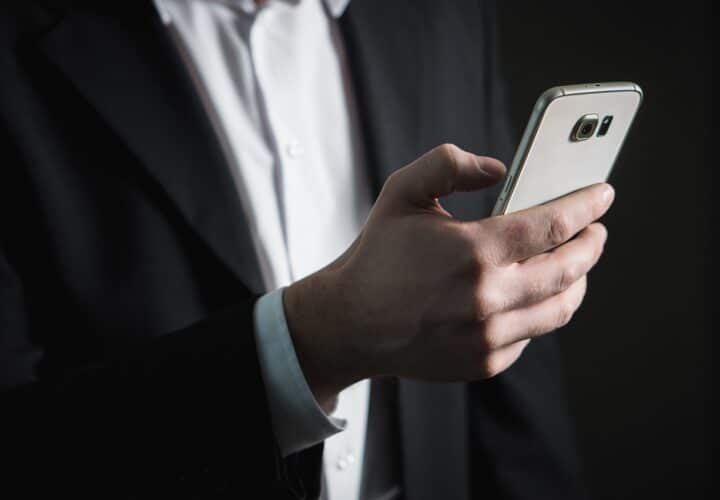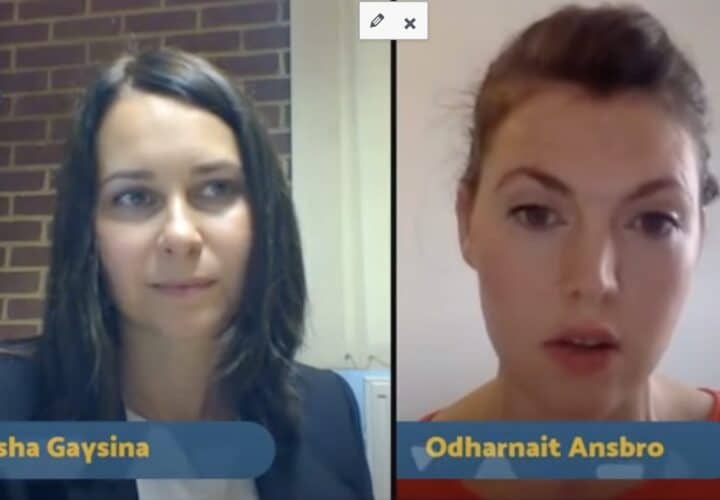Pediatrician and brain researcher Dr. John Hutton discusses the impact of screen time on children's brains.
Screens are everywhere in modern society. The smartphones we carry in our pockets. Our laptop computers. Televisions. Car dashboards. Even many grocery stores now have them at self-checkout. And research shows the average American gets hours of screen time every day. There’s no question all these screens are affecting our brains. The only question is how.
Dr. John Hutton has some answers. Hutton is an associate professor in the Division of General and Community Pediatrics at University of Texas Southwestern Medical Center and a primary care pediatrician at Children’s Health, Dallas. Over the course of the last decade, Dr. Hutton and a team of researchers published the first studies in the world using MRIs to show the relationships between digital media use and brain function and structure in preschool-age children.
But Hutton isn’t only a doctor and researcher. Outside the professional realm, Hutton spent 20 years leading Blue Manatee Children’s Bookstore, an award-winning independent bookstore donated in 2019 to create a non-profit, the Blue Manatee Literacy Project. In this capacity, he has published more than 40 children’s books, many with health-promoting themes around dialogic reading and limiting screen time. He also serves as “spokesdoctor” for the “Read Aloud 15 MINUTES” campaign on the National Medical Advisory Board of Reach Out and Read, and was co-author of the American Academy of Pediatrics Literacy Promotion Guidelines, released in 2024.
Hutton recently sat down with Being Patient founder Deborah Kan to unpack the complicated issue of screen time, and answered questions about how much screen time is too much, how screen time affects the brain, and what young people can do to keep their brains healthy at a time when screens are so prevalent. Read on for highlights of the session or watch the full Live Talk below.
Being Patient: To what extent can early exposure to screens affect kids in the 3- to 5-year-old range?
Dr. John Hutton: The evolution of screen time with young children is a great, uncontrolled experiment where we’ve fundamentally changed how kids are experiencing the world, starting in infancy. Technology has grown so fast compared to research. We know for sure that despite American Academy of Pediatrics recommendations, which are to keep kids off screens until about a year and a half, infants as young as six months or even younger are being first exposed to TV, then tablets and other devices. [This has] really changed everything in terms of the older kids, because they’re getting them at younger ages. The media is following them around in ways that it never did when we were kids.
A lot of the data is dependent on [parents reporting it to researchers], and parents tend to under-report how much screen time their kids have, so [we] are trying to come up with more objective measures. Phones can sometimes track how much app use kids are having, [and] recent surveys have estimated the youngest kids [use] anywhere from an hour to an hour and a half, and teenagers [use] devices for eight to 10 hours per day.
“The evolution of screen time with
young children is a great, uncontrolled
experiment where we’ve fundamentally
changed how kids are experiencing
the world, starting in infancy.”
Being Patient: What have you discovered through your research?
Hutton: There’s a maxim in brain science that ‘Neurons that fire together, wire together.’ So whatever a child is doing starting in infancy is going to reinforce the brain circuits that are involved with processing those things. My research has really drilled down on the 3 to 5 [age range]. I’ve used both structural and functional MRIs, and to do that, you must have kids be able to participate and sit still in the scanner, and that’s about the youngest where you can really play games with them and convince them [to do it for] 30 minutes. About 80 percent of kids finish a scan. A lot of my early research involved literacy. I was interested in reading: What are the impacts of reading books at home? The screen part came in as almost a secondary where we also asked the parents about their child’s media use. We did whole brain analyses, looking at what are the impacts on the whole brain, and then specific brain networks involved with language or literacy or visual processing.
Being Patient: What did you find about the impact of screen time on literacy levels?
Hutton: There’s been some debate [about] the impact of screen time on literacy skills. We know that there are effects. It’s probably most likely that screen time tends to displace the reading experience. There are only so many hours in the day, and if a child is on a device or watching TV, then they’re going to have less time to read with their parents or other caregivers. The amount of reading that’s reported at home has really been about the same for the past 30 years. It’s low, about 15 minutes per day, you know, at best. Whereas screen use has gone up to multiple hours per day. [There also are] direct impacts of different types of media use on the brain and brain networks. Specifically, fast-moving content that’s hyper stimulating, violent content that activates parts of the brain involved with fight or flight, and fast-moving videos [with] rapid scrolling that are more dopamine-stimulating.
“There are only so many hours in the day, and
if a child is on a device or watching TV, then
they’re going to have less time to read
with their parents or other caregivers.”
Being Patient: What does all of this do to our brains, physiologically?
Hutton: There’s not a lot of brain imaging research out there at young ages. But backing up a little bit to my own research, we’ve published several studies that specifically look at digital media use for screen time on measures of early brain development. The highest profile [project] involved a study that was structural in nature, that was looking at white matter development, and it was published in JAMA in 2000. The measure we used was called the ScreenQ—it’s a 16-item measure that [assesses different uses of screens against American Academy of Pediatrics guidelines]. We found that higher scores on the ScreenQ or greater non-adherence with guidelines [were] associated with lower measures of white matter, maturation, myelination, literacy skills, and executive function. We also administered cognitive measures; kids with [less] white matter development also had lower vocabulary skills, lower phonological skills, lower measures of executive function and lower overall early literacy skills. This was controlled for age, sex and household income.
Being Patient: What’s the difference between white matter and grey matter?
Hutton: The gray is the surface of the brain—it’s a very thin surface on the cortex, like the skin of an apple. Basically, it’s where all the synapses form. These synapses are involved with higher-order skills like language and vision and other things. The white matter is the wires that connect all the cells to one another and allow them to form networks. The reason it’s white is that it’s coated in a fatty substance called myelin, which is sort of like the rubber on a wire in your house. It insulates the fiber tracks and makes them faster and more efficient. White matter develops in direct proportion to how much it’s used. Tracks involved with language are going to get thicker and more myelinated and more efficient, and then gray matter. By contrast, the maturation of gray matter is more complicated. It follows a whole different sort of developmental pathway.
“White matter develops in direct
proportion to how much it’s used.”
Being Patient: You concluded that more screen time led to a slowdown in both the growth of white matter in the brain as well as developmental literacy. Is that correct?
Hutton: That’s right. We did another study where we looked at gray matter development, and we found that similarly, kids with higher screen use scores had thinner areas of [the] cortex of their brain in a couple of different places. One was in visual areas, which was attributed to just greater efficiency of that part of the brain. It also [was] thinner in areas of the brain that are involved with social cognition, reasoning, and empathy. That was a concerning finding, in the sense that that area of the brain should be thickening at that age, rather than [thinning].
Being Patient: To what extent can your brain recover if screen usage has resulted in the thinning of your white matter?
Hutton: We know the brain is very plastic throughout our life. The brain has a remarkable ability to recover from all kinds of things, but the key is making significant changes. If a child becomes addicted to playing video games, and they won’t come out of their bedroom and you worry about their ability to self-regulate and interact with other kids, if you make the dramatic change and somehow get them off, it’s possible to rewire their circuits. It’s just a matter of really making significant changes to their lifestyle [regarding screen use].
“The brain has a remarkable ability to
recover from all kinds of things, but the
key is making significant changes.”
Being Patient: What about teenagers?
Hutton: There’s a very large ongoing longitudinal study called the ABCD study, which involves pre-adolescents and now adolescents. [This] specifically is looking at mental health as one of its primary outcomes. They’ve released a couple papers; one [focuses on the] differences in cortical thickness related to screen use, and that lines up with what we found and also greater manifestations of anxiety. [These young people show higher] incidents of anxiety, depression, [and other] externalizing behaviors. There’s a connection with social media [and] kids [who] are predisposed to being anxious or are predisposed to more aggressive behaviors. The two age ranges I worry about are 0-5, when the brain’s growing rapidly, and then adolescence, when the brain [also] is growing rapidly. In the first case, kids are trying to understand the real world. [In the second], they’re trying to figure out where they fit in the real world.
Being Patient: What’s your next area of study?
Hutton: I’m interested in conducting some longitudinal research looking at a number of different outcomes [with kids aged] 3 to 5. [This time] we’re looking at not just literacy, but [also] math skills, social skills, and executive function. The other area I’m really interested in: differential susceptibility. [This] is the idea that not all kids are going to have the same impacts from screen use. You know, if you have a room full of 100 and they all watch the same amount of screen time, 20 percent will benefit, 60 percent [will have mixed results], and 20 percent will really crash. [This last group are] the ones [who] are going to be terribly anxious. They’re going to get hooked on their screens.
“One of my taglines is, ‘Screen free until three.’
As much as possible, stay engaged with your child,
especially younger ones, and put your own phone away.”
Being Patient: Finally, what are the screen-time rules in your house, John?
Hutton: One of my taglines is, ‘Screen free until three.’ We tried with our kids. I have three daughters: 31, 27, and 19, and the 31-year-old looks at the 19-year-old [and says,] ‘Back in my day, we didn’t have tablets.’” It’s funny seeing how much things have changed. But, yeah, the longer you can keep kids off the screens and get them anchored in the real world, the better. As far as specific behaviors, I used to be more of an hour-limit person, but now, both with my own kids and with my patients, I focus on context of use. What are the situations in your own home where it’s okay to use screens [and it’s not OK to use them]? Mealtime, for example, let’s try to put them away. Bedtime is another. The more you can keep [screens] out [of the bedroom], especially for younger kids, the better we know they tend to [cope]. So I think those are contextual things that can make a big difference. [Another thing:] Parents looking at their own screens, because kids are watching you, and if you’re on your phone at the park, [they might think,] ‘The park’s not as fun as the phone, so let’s use a phone instead.’ As much as possible, stay engaged with your child, especially younger ones, and put your own phone away. [It’s important to] give yourself a break from the phone, too.
Matt Villano produces Live Talks for Being Patient, and is a writer and editor based in Healdsburg, California.




